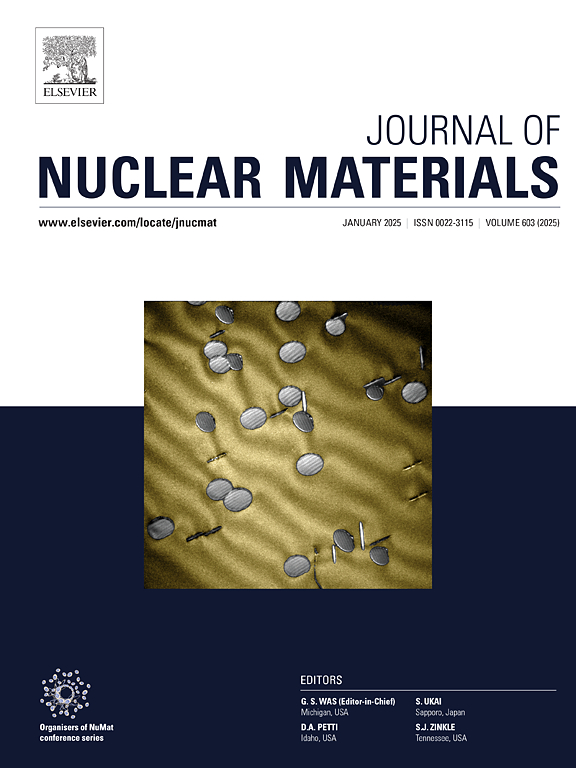空位对AlNbTiZr/Zr界面稳定性影响的第一性原理研究
IF 2.8
2区 工程技术
Q3 MATERIALS SCIENCE, MULTIDISCIPLINARY
引用次数: 0
摘要
当AlNbTiZr涂层中存在缺陷时,AlNbTiZr/Zr界面的结构和性能发生显著变化。然而,缺陷对界面键合的影响缺乏定量评估,实验研究结果也难以指导界面结构的设计。本文采用第一性原理计算方法研究了具有不同空位缺陷类型和空位形成能(VFE)的AlNbTiZr/Zr的界面结构,并通过量化界面能和粘附功来计算界面键合。有趣的是,与纯Zr相比,在界面的基体侧VacZr的VFE (Zr空位)更高,这使得它更难以形成。这说明高熵包层抑制了空位的形成,提高了Zr包层的初始抗辐照能力。无论空穴类型如何,含空穴界面的界面能较高,附着功低于完美界面。因此,它们不如完美界面稳定,这意味着空位削弱了界面的稳定性。具有真空空位(VacAl)的界面稳定性最差。由此可以推断,在实验研究过程中,应尽量减小涂层界面处Al空位的浓度。电荷分析结果表明,与含有空位的界面相比,完美界面处电荷重排和积聚更为明显。此外,Al-p与Zr-eg和zr -t2轨道的PDOS在完美界面处表现出更强的电子耦合,表明化学键更强。这进一步表明,空位削弱了界面的结合强度和稳定性。这些结果为从界面稳定性的角度探讨空位对AlNbTiZr/Zr界面性能的影响提供了新的见解,对Zr合金熔覆高熵涂层领域具有重要意义。本文章由计算机程序翻译,如有差异,请以英文原文为准。
Effect of vacancy on the stability of the AlNbTiZr/Zr interface: a first-principles study
The structure and properties of AlNbTiZr/Zr interface change significantly when defects are present within AlNbTiZr coating. However, the effect of defects on interfacial bonding lacks quantitative assessment, and the results of experimentally studies are also difficult to guide the design of interface structures. In this paper, the interfacial structure of AlNbTiZr/Zr with different kind of vacancy defect types and vacancy formation energy (VFE) has been investigated by first-principle calculations, and the interfacial bonding was calculated by quantifying the interfacial energy and adhesion work. It is interesting that VFE of VacZr (Zr vacancy) is higher in the matrix side of the interface than in pure Zr, making it harder to form. This implies the high-entropy coating suppresses vacancy formation, enhancing initial irradiation resistance of Zr cladding. Regardless of the type of vacancy, the interfacial energy of interfaces containing vacancies is higher, and the adhesion work is lower than that of perfect interfaces. Therefore, they are less stable than perfect interfaces, meaning that vacancies weaken the stability of the interface. Moreover, interfaces with VacAl (Al vacancy) exhibit the poorest stability. It can be inferred that during experimental research, efforts should be made to minimize the concentration of Al vacancies at the coating interface. According to the charge analysis results, compared to interfaces containing vacancies, there is more pronounced charge rearrangement and accumulation at the perfect interface. Additionally, the PDOS of Al-p with Zr-eg and Zr-t2g orbitals shows stronger electronic coupling at the perfect interface, indicating stronger chemical bonding. This further demonstrates that vacancies weaken the bonding strength and stability of the interface. These results have important implications for the field of Zr alloy cladding high-entropy coating, as they provide new insights from the perspective of interfacial stability to discuss the effect of vacancy on the performance of AlNbTiZr/Zr interface.
求助全文
通过发布文献求助,成功后即可免费获取论文全文。
去求助
来源期刊

Journal of Nuclear Materials
工程技术-材料科学:综合
CiteScore
5.70
自引率
25.80%
发文量
601
审稿时长
63 days
期刊介绍:
The Journal of Nuclear Materials publishes high quality papers in materials research for nuclear applications, primarily fission reactors, fusion reactors, and similar environments including radiation areas of charged particle accelerators. Both original research and critical review papers covering experimental, theoretical, and computational aspects of either fundamental or applied nature are welcome.
The breadth of the field is such that a wide range of processes and properties in the field of materials science and engineering is of interest to the readership, spanning atom-scale processes, microstructures, thermodynamics, mechanical properties, physical properties, and corrosion, for example.
Topics covered by JNM
Fission reactor materials, including fuels, cladding, core structures, pressure vessels, coolant interactions with materials, moderator and control components, fission product behavior.
Materials aspects of the entire fuel cycle.
Materials aspects of the actinides and their compounds.
Performance of nuclear waste materials; materials aspects of the immobilization of wastes.
Fusion reactor materials, including first walls, blankets, insulators and magnets.
Neutron and charged particle radiation effects in materials, including defects, transmutations, microstructures, phase changes and macroscopic properties.
Interaction of plasmas, ion beams, electron beams and electromagnetic radiation with materials relevant to nuclear systems.
 求助内容:
求助内容: 应助结果提醒方式:
应助结果提醒方式:


